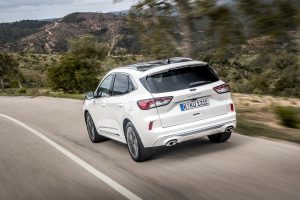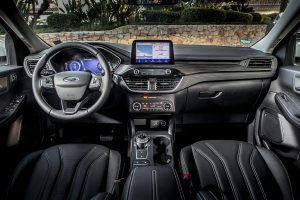Car Dealer Magazine’s Darren Cassey delivers his verdict on the plug-in hybrid Ford Kuga
What is it?
The Kuga has been a staple of Ford’s range since 2008, and after a slow start it became one of the brand’s most popular models.
The latest generation is bigger than before with a whole new styling direction, and sits on a brand new platform called ‘C2’. It’s big news as it allows Ford to offer a wide range of powertrains – petrol, diesel, diesel mild hybrid and, the car tested here, a petrol plug-in hybrid.
What’s under the bonnet?
The hybrid powertrain uses a 2.5-litre petrol engine combined with an electric motor and generator that are powered by a 14.4kWh battery. This provides a decent, usable electric-only range of 35 miles, which means you could get away with rarely even using the petrol engine.
It makes a total of 222bhp with a top speed of 125mph. Fuel economy figures are pretty wild at 202mpg, but only if you’re regularly topping up the batteries and only taking short trips is that a possibility, though we saw economy figures in the 60s during mixed driving. CO2 emissions are low, at just 32g/km.
It’s a rather hit and miss powertrain to use. At lower speeds where the electric motor is doing most of the work it’s brilliant, providing smooth but punchy response and silent operation. At motorway speeds with the engine on it’s still quiet enough, and even when the engine kicks in around town it’s not too intrusive. However, the CVT gearbox means that accelerating harder using the petrol engine is unrewarding with an unappealing soundtrack to boot.

What’s it like to drive?
There’s a lot to like about the Kuga, but it doesn’t deliver full marks. First, the positives. As we’ve come to expect from Ford products, it handles well, doing a good job of restraining its heft in corners, while also not being intimidating to drive around town thanks to the smooth and responsive electric motor.
However, there are quite a few negative aspects to the driving experience, such as the bizarre, rubbery self-centring of the steering wheel as you turn – something common to Fords but most prominent in the Kuga. Meanwhile, the brake pedal gives little feedback but is very sensitive, which makes slowing down smoothly difficult. We’re also not convinced by the ride, with it feeling very heavy over bumps.
How does it look?
While previous generations of the Kuga wore chunky ‘I’m an SUV’ styling, the latest model ditches this in favour of a sleeker appearance. From a distance it looks like a family hatchback rather than an SUV, meaning it stands out less than rivals on the road but still offers the high driving position and practicality that has made this segment so popular.
Aside from the softer styling, some of this non-SUV look is achieved by having a more reclined windscreen and lower roof angle, which hides its height. Despite this appearance, it’s actually bigger than the outgoing model…

What’s it like inside?
The cabin is one of the Kuga’s trump cards, because it feels exceptionally well made. Our top-spec Vignale model also comes incredibly well-specified, with high-quality materials used throughout and luxury extras such as a heated steering wheel and leather-wrapped instrument panel helping to improve the overall feel.
It’s very spacious too, making it ideal for families. Rear seat passengers, big and small, will have plenty of leg room, while boot space is decent at 411 litres, even if it is less spacious than non-hybrid versions.
If you’re not looking to stretch to the price of a top-spec model – or just don’t fancy putting premium leather at the mercy of the kids – the Kuga’s interior has all the practicality and build quality you could need in a family car, regardless of trim level.
What’s the spec like?
There are five trim levels available for the Kuga: Zetec, Titanium, ST-Line, ST-Line X and Vignale. However, if it’s this plug-in hybrid powertrain you’re after, that excludes Zetec.
Prices start at £33,085 for the Titanium PHEV, and rise through the sporty-looking ST-Line models to the luxury-focused Vignale we’ve been testing. For this, prices start at £37,785 and equipment includes 19-inch alloy wheels, full-LED headlights with automatic anti-glare full beam, premium leather seat trim with heated front seats and heated steering wheel, Vignale body kit, metallic paint, a fully digital 12.3-inch instrument cluster, automated park assist and a head-up display.
Traditionally, Ford’s Vignale trim levels have felt like an unnecessary expense over less expensive but still generously equipped trims. However, commanding only a few grand more than the ST-Line trims, the Vignale PHEV feels like good value for money, especially if you’re more focused on comfort than sporty looks.
What do the press say?
Autocar said: ‘The Kuga has lost none of its dynamic flair, yet it’s more refined and practical than ever. Perhaps the only real niggle is that the interior fails to achieve that premium feel Ford has been striving for. We also suspect the cheaper petrols will be the pick of the line-up.’
What do we think?
The Ford Kuga PHEV is so close to being great. Its styling is sleek and unimposing, the interior is well made and spacious, and the electrified portion of its powertrain makes for a relaxing, effortless driving experience. What’s more, keep the batteries topped up and that useful electric range means running costs should be very low indeed.
However, it’s hard to get away from the fact it’s a bit of a letdown from behind the wheel. The inconsistent control weights make smooth driving a chore and detract from what should be a brilliant family SUV. A test drive is highly recommended, because if you can live with those negatives you’ve got yourself a handsome, practical SUV.
The knowledge
Mode: Ford Kuga PHEV Vignale
Base price: £37,785
Engine: 2.5-litre petrol engine and electric motor
Power: 222bhp
Torque: N/a
Max speed: 125mph
0-60mph: 9.2 secs
MPG: 202mpg
Emissions: 32g/km CO2
TARGET BUYERS
Families perhaps considering their first PHEV and company car drivers
THE RIVALS
Vauxhall Grandland X Hybrid, Peugeot 3008 Hybrid4, Mitsubishi Outlander PHEV
KEY SELLING POINTS
- Efficient powertrain
- Quiet on the move
- Decent boot room and interior space
DEAL CLINCHER
Handles better than rivals


































